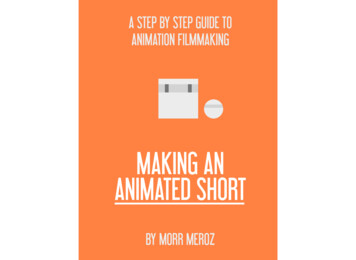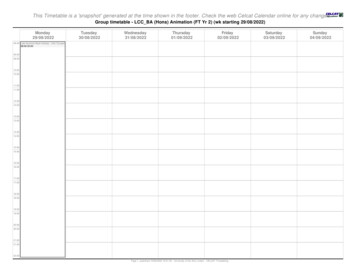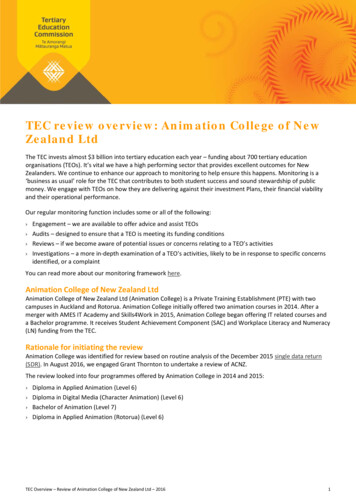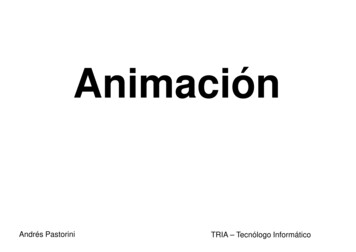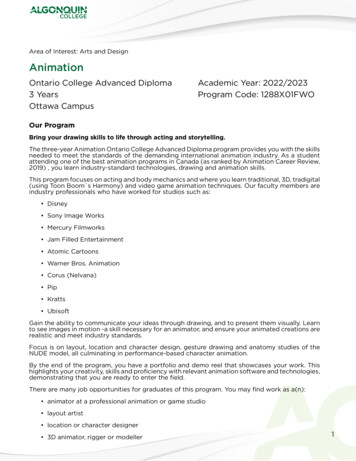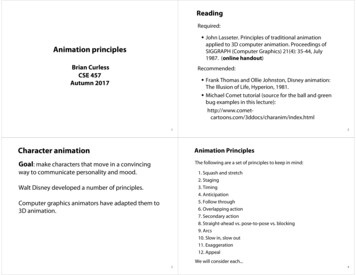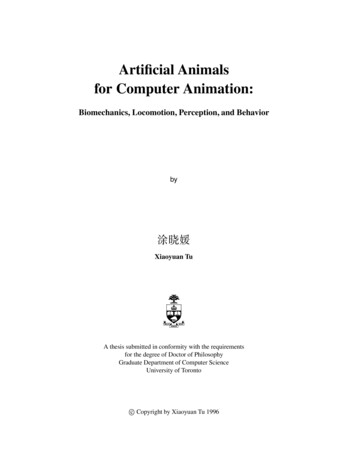
Transcription
Artificial Animalsfor Computer Animation:Biomechanics, Locomotion, Perception, and BehaviorbyXiaoyuan TuA thesis submitted in conformity with the requirementsfor the degree of Doctor of PhilosophyGraduate Department of Computer ScienceUniversity of Torontoc Copyright by Xiaoyuan Tu 1996
cXiaoyuan Tu 1996ALL RIGHTS RESERVED
Artificial Animals for Computer Animation:Biomechanics, Locomotion, Perception, and BehaviorDoctor of Philosophy, 1996Xiaoyuan TuDepartment of Computer Science, University of TorontoAbstractThis thesis develops an artificial life paradigm for computer graphics animation. Animals in theirnatural habitats have presented a long-standing and difficult challenge to animators. We proposea framework for achieving the intricacy of animal motion and behavior evident in certain naturalecosystems, with minimal animator intervention.Our approach is to construct artificial animals. We create self-animating, autonomous agentswhich emulate the realistic appearance, movement, and behavior of individual animals, as well asthe patterns of social behavior evident in groups of animals. Our computational models achievethis by capturing the essential characteristics common to all biological creatures—biomechanics,locomotion, perception, and behavior.To validate our framework, we have implemented a virtual marine world inhabited by a variety ofrealistic artificial fishes. Each artificial fish is a functional autonomous agent. It has a physics-based,deformable body actuated by internal muscles, sensors such as eyes, and a brain with perception,motor, and behavior control centers. It swims hydrodynamically in simulated water through thecontrolled coordination of its muscle actions. Artificial fishes exhibit a repertoire of behaviors.They explore their habitat in search of food, navigate around obstacles, contend with predators, andindulge in courtship rituals to secure mates. Like their natural counterparts, their behavior is basedon their perception of the dynamic environment and their internal motivations.Since the behavior of artificial fishes is adaptive to their virtual habitat, their detailed motionsneed not be keyframed nor scripted. This thesis therefore demonstrates a powerful approach tocomputer animation in which the animator plays the role of a nature cinematographer, rather thanthe more conventional role of a graphical model puppeteer. Our work not only achieves behavioralanimation of unprecedented complexity, but it also provides an interesting experimental domain forrelated research disciplines in which functional, artificial animals can serve as autonomous virtualrobots.i
AcknowledgmentFirst, I would like to thank my advisors Demetri Terzopoulos and Eugene Fiume. This thesiswould not have been possible without their support.Demetri has been my mentor in the exciting fields of computer animation and physics-basedgraphics modeling. His many remarkable qualities have benefited me greatly. I am most impressedby his breadth of knowledge, his ability to seize new ideas,his openmindedness, and his perfectionismtowards technical writing. I am especially grateful for the unfailing encouragement he has given methrough the years. I would not have come this far this quickly without his expert guidance and thesubstantial time and effort he has put into my thesis.I thank Eugene for giving me the chance to join the graphics group three years ago. Withouthis kindness, I would have been stuck studying boring operating systems (no offense intended). Iappreciate his many insightful comments that have helped to improve my thesis and to put my viewinto perspective.My special thanks go to Professor Daniel Thalmann for generously agreeing to serve as externalexaminer of my thesis, despite his busy schedule and the long distance he had to travel. Specialthanks also go to Professor Janet Halperin for serving as internal examiner and Professor MichielVan de Panne for serving as internal appraiser on my thesis committee. Many thanks to ProfessorsKen Sevcik and Geoffrey Hinton for serving on my committee and providing valuable comments onmy thesis.I thank the wonderful people of the graphics and vision labs. My years at U of T would have beendull without them. I would like to express my sincere gratitude to Tamara Stephas, Meng Sun, VictorNg, Xiaohuan Wang, Petros Faloutsos, Jeremy Cooperstock, Radek Grzeszczuk, Beverly Harrison,Kevin Schlueter, Michael McCool, Alex Mitchell, Jeff Tupper, Jos Stam, Sherif Ghali, Joe Laszlo,William Hunt and Baining Guo from the graphics lab, and Tim McInerney, Victor Lee and XuanJu from the vision lab. My deep appreciation to my friends from other groups in the department,Vincent Gogan, Steven Shapiro and Michalis Faloutsos, and, from elsewhere, Yuxiang Wang, WeiXu, Tina Shapiro and Christopher Lori. Particularly, I thank my colleague Radek Grzeszczuk, forii
collaborating in the production of “Cousto”. Thanks also to Kathy Yen for helping me to deal withthe many tedious details in arranging my defense.I would especially like to thank Michiel Van de Panne, who was a student at the graphics labwhen I started my PhD program and now, as I finish, is a professor. He has always been verygenerous in helping others around the lab. He taught me how to use the video equipment andprovided substantial assistance in the production of my animations.I thank my parents, to whom I dedicate this thesis, for their endless love and support, for theirunwavering confidence in me and their limitless patience. They are the best parents I could haveever dreamed to have.Finally, thanks to my partner John, for his love, support, help (both as a colleague and a friend)and the wonderful times he brings me.iii
iv
Contents1 Introduction1.11.21.31.41.51 Challenges 1.2.1 Conventional Animation Techniques Methodology: Artificial Life for Computer Animation 1.3.1 Criteria and Goals 1.3.2 Artificial Animals 1.3.3 From Physics to Realistic Locomotion 1.3.4 Realistic Perception 1.3.5 Realistic Behavior 1.3.6 Fidelity and Efficiency Contributions and Results 1.4.1 Primary Contributions 1.4.2 Auxiliary Technical Contributions Thesis Overview Motivation2 Background2.12.212355568891011141517 2.1.1 Constraint-based Approach 2.1.2 Motion Synthesis Approach Behavioral Animation Physics-Based Modelingv17181922
2.2.2 Control of Behavior The Modeling of Action Selection 2.3.1 Defining Action 2.3.2 Goals and Means 2.3.3 Previous Work 2.3.4 Task-level Motion Planning Summary 2.2.12.32.4Perception Modeling3 Functional Anatomy of an Artificial Fish3.13.23.34.24.34.44.54.6 Perception System Behavior System Motor System252527283030 Structure of the Dynamic Fish Model Mechanics 4.3.1 Viscoelastic Units Muscles and Hydrodynamics Numerical Solution 4.5.1 System Matrix Assembling and the Skyline Storage Scheme 4.5.2 Algorithm Outline and Discussion Motor Controllers 4.6.1 Muscle Motor Controllers 4.6.2 Pectoral Fin Motor Controllers Discrete Physics-Based ModelsConstructing 3D Geometric Fish Modelsvi353535375 Modeling the Form and Appearance of Fishes5.124334 Biomechanical Fish Model and Locomotion4.123 37384141444648515253575959
5.25.35.45.5 5.2.1 Deformable Mesh Texture-Mapped Models Coupling the Dynamic and Display Models Visualization of the Pectoral Motions Obtaining Texture Coordinates6 Perception Modeling6.16.26.36.46.56.66.7626364656771 Overview of the Artificial Fish’s Perception System Vision Sensor Modeling 6.3.1 Perceptual Range 6.3.2 Occlusion 6.3.3 Functionality Computing Visibility 6.4.1 Visibility of a Point 6.4.2 Visibility of Another Fish 6.4.3 Visibility of a Cylinder 6.4.4 Visibility of Seaweeds 6.4.5 Discussion The Focusser 6.5.1 Focus of Attention in Animals 6.5.2 Design of the Focusser 6.5.3 Summary From Perception to Behavior 6.6.1 An Example: Collision Detection Synthetic Vision Models Perception Modeling for Animation7 The Behavior System7173737475757777808080818282838687879093vii
7.17.27.37.47.57.67.77.87.97.10 Behavior Control and Ethology 7.2.1 The Intention Level 7.2.2 The Action Level 7.2.3 Summary Habits Mental State Intention Generator 7.5.1 Why Hierarchy? Intention-Guided Perception: Control of the Focusser Persistence in Behavior 7.7.1 Behavior Memory 7.7.2 Inhibitory Gain and Fatigue 7.7.3 Persistence in Targeting Behavior Routines 7.8.1 Primitive Behavior: Avoiding Potential Collisions 7.8.2 Primitive Behavior: Moving Target Pursuit Artificial Fish Types 7.9.1 Predators 7.9.2 Prey 7.9.3 Pacifists Discussion 7.10.1 Analysis 7.10.2 Summary Effective Action Selection Mechanisms8 Modeling the Marine 06107108108112112114119124124126129 Seaweeds and Plankton Water Currentviii129130
9 The Graphical User Interface9.19.29.39.4133 Manipulation Panels Control Panels Discussion Initialization Panels10 Animation Results133134137138141 “The Undersea World of Jack Cousto” Animation Short: Preying Behavior Animation Short: Schooling Behavior Animation Short: Mating Behavior 10.1 “Go Fish!”14110.214410.310.410.511 Conclusion and Future Work144146147149 Additional Impact in Animation and Artificial Life Impact in Computer Vision and Robotics Potential Applications in Ethology Other Artificial Animals Future Research Directions 11.6.1 Animation 11.6.2 Artificial Life 11.1 5157A Deformable Contour Models158B Visualization of the Pectoral Motions161 Animating the Pectoral Oaring Motion B.1 Animating the Pectoral Flapping Motion161B.2163C Prior Action Selection Mechanisms164ix
C.1 Behavior Choice Network164C.2 Free-Flow Hierarchy165D Color Images173x
List of Figures1.11.2Artificial fishes in their physics-based world. See the original color image in Appendix D . 12Mating behavior. Female (top) is courted by larger male. See the original color imagein Appendix D . 121.3Predator shark stalking school of prey fish. See the original color image in Appendix D . 132.1Differentiating action selection from motor control in design.3.1System overview of the artificial fish.4.1The motor system of an artificial fish.4.24.34.44.54.64.74.84.94.104.114.124.134.14 26 34 The biomechanical fish model. The top and side view of the outline of the fish model at rest. Uniaxial elastic, viscous, and viscoelastic units. Hydrodynamic locomotion. Structure of the system matrix. The skyline storage scheme. Top view of an artificial fish during caudal swimming motion. Photograph of real fish swimming. Top-front view of an artificial fish during caudal swimming motion. The steering map. The turning motion of the artificial fish. The pectoral fin geometry. The local coordinate system of a fish. xi3840404245495055555556565758
5.12 Control-point mesh of the left half of a fish body. The shaded NURBS surface of the left half of a fish body. Geometric model of fish body with fins. Control-point mesh fish models. Initial and stabilized deformable mesh. Texture mapped 3D fish models. The subdivision of the faces of the dynamic fish. Geometric mesh surface overlayed on dynamic fish model. The geometric NURBS surface fish deforms with the dynamic fish. Snapshots of the pectoral flapping motion. Snapshots of the pectoral oaring motion of a butterfly fish. 6.1The perception system in an artificial fish.5.15.25.35.45.55.65.75.85.95.105.11Digital images of real fish.6.3 Vision sensor. Occlusion and distance limit visual perception. 6.4Fisheye view of the world showing fishing line. See the original color image in Appendix6.26.9 Fisheye view of the world showing hooked fish. Occlusion test. Swimming fishes avoiding collisions with cylindrical obstacles. The fish’s collision sensitivity region. Analogues of intrinsic images. 7.1The behavior system in an artificial fish.D.6.56.66.76.87.27.37.47.5 The control scheme for action selection. The form of the stimulus functions and . Generic intention generator. Outline of chasing-target routine. 00102109
7.21 A peaceful marine world. See the original color image in Appendix D . The smell of danger. See the original color image in Appendix D . The intention generator of a predator. The angle . A hungry predator ingesting prey. Portion of intention generator of prey. Schooling behavior routine. A small school of angelfish. An inceptive school. A school of fish encounters an obstacle. School scatters in terror. Fleeing from predator. Mating behaviors in real fishes. Two males (larger) vying for the attention of a female. A clownfish displays opportunism in behavior. 8.1The flow 67.177.187.197.20The position of target relative to fish.8.3 The swaying motion of a seaweed in simulated water currents. The seaweed responds to hydrodynamic forces produced by a passing fish. 9.1The object initialization panel.8.29.29.39.49.59.69.7 The position initialization panel. The physical parameter panel. The behavior panel. The habit panel. The general control panel. The fishview control panel and the rendered identity maps from fish ‘1’. 26129131132134135135136137138139
Hungry fishes approaching the hook. A hapless fish is caught and pulled to the surface. A dangerous shark stalking a school of prey. A school of fleeing prey. A pair of courting pokerfish. 10.1 Denizens of the virtual marine world happily feeding on 7 A large predator hunting small prey fishes while pacifist fishes, untroubled by thepredator, feed on plankton. 147 151 16211.1 Locomotion learning center in the brain of the artificial fish.B.1 Visualization of pectoral fin motion.xiv
Chapter 1IntroductionA kangaroo hops across a barren plain. It leaps and lands rhythmically. The harmonic movementsof its body, legs and tail trace out graceful curves in the air. A flock of birds glides across the sky.Individual birds flap their wings and adjust their direction autonomously, yet they all fly in unison.1.1 MotivationAnimals in motion have intrigued computer graphics animators and researchers for several decades.They have long been the subject of study of zoologists and ethologists, and have recently helpedinspire the emerging research discipline of artificial life.In computer graphics, most animations of animals have been created using the traditional andoften highly labour intensive keyframing technique, in which computers are employed to interpolatebetween animator-specified keyframes (Lasseter, 1987). More recently, increasingly automatedtechniques for synthesizing realistic animal motion have drawn much attention. Successful attemptshave been made to animate the motions of humans (Magnenat-Thalmann and Thalmann, 1990;Hodgins, Sweeney and Lawrence, 1992), of certain animals (Miller, 1988; Girard, 1991) and ofsome imaginary creatures (Witkin and Kass, 1988; van de Panne and Fiume, 1993; Ngo and Marks,1993). However, motion synthesis is only part of the challenge of animating animals. Some groupbehaviors evident in the animal world, such as flocking, schooling and herding (Reynolds, 1987)have also been simulated and realistically animated in recent feature films.In this dissertation, we will investigate the problem of producing animation which captures1
CHAPTER 1. INTRODUCTION2the intricacy of motion and behavior evident in certain natural ecosystems. These animations areintrinsically complex and present a challenge to the computer graphics practitioner. Animationsof this sort are of interest not only because they attempt to recreate fascinating natural scenarios,but also because they have broad applicability. They can be used in the entertainment industry, forspecial effects in movies, for video games, for virtual reality rides; as well as in education as, say,interactive educational tools for teaching biology.Our goal will be to create the animations that we have described, not by conventional keyframing,but rather through the sophisticated modeling of animals and their habitats. To this end, we havebeen motivated by and have contributed to the artificial life (ALife) movement (Levy, 1992). ALifecomplements the traditional analytic approach of biology by aiming to understand natural lifethrough synthetic, computational means. That is to say, rather than studying biological phenomenaby analyzing living systems, the ALife approach attempts to synthesize artificial systems that behavelike living organisms. An important area of ALife research is the synthesis of artificial animals—or“animats”—implemented both in software and in hardware (Meyer and Guillot, 1991; Cliff et al.,1994). Computational models of simple animals, such as single-cell life forms (Langton, 1987) andinsects (Beer, 1990), have been proposed with interesting results. Many of these models draw upontheories of animal behavior put forward by ethologists (Manning, 1979; McFarland, 1971).Since we will view the animation of natural ecosystems as the process of visualizing computersimulations of animals in their habitats, our work straddles the boundary between the fields ofcomputer graphics and artificial life. This theme has also been investigated by Terzopoulos et al.(1995).1.2 ChallengesNatural ecosystems are as challenging to animate as they are fascinating to watch. The majorchallenge comes from their intrinsic complexity. In a given animation system, there may be a largenumber of animals, each of which may exhibit elaborate behaviors. Ideally, one would like to achievean abundance of natural intricacy with minimal effort on the part of the animator. The challengeis exacerbated when one also demands visual authenticity in the appearance and locomotion ofindividual animals and in their behavior.Ecosystems are characterized by the relationships between animals and their habitats. This meansthat when we look at an ecosystem, we are keenly aware of the behaviors exhibited by animals as
1.2. CHALLENGES3they interact with their dynamic environment, especially with other animals. For example, a huntingscenario will not seem authentic if a rabbit hops around carelessly disregarding the presence ofa hungry wolf, or if a crowd of pigeons rest calmly while a child runs in their midst. People’sfamiliarity with various animals imposes strict criteria for the evaluation of the visual results of ourproposed simulations, since even small imperfections in the animated motions or behaviors will bereadily recognizable.Visual realism, however, is not the only constraint on such animations. For applications in theentertainment and educational industries, the animator should be able to control various aspects ofan animation. It is especially important to be able to easily modify an animation; for example,altering the virtual environment, changing the number, types and distribution of the virtual animalsand, moreover, varying the personalities of the animals and even interacting with them.1.2.1 Conventional Animation TechniquesTraditional computer animation techniques, such as keyframing, have been used to create manygreat animations, including those of animals. However, they have several limitations:Significant Animator Intervention is RequiredPerhaps the most spectacular instance to date of conventional animation techniques applied to theanimation of animals is the dinosaurs in the blockbuster feature film “Jurassic Park” (a 1993 AmblinEntertainment Production for Universal Pictures). Yet as realistic looking as they may be, thesedinosaurs are merely graphical puppets which require teams of highly skilled human animators toplot their actions and detailed motions carefully from one step to the next. This reveals the maindrawback of keyframing: The amount of effort expended by the animator increases dramaticallywith the length, complexity and intended realism of the animation.Techniques that do not require as much animator skill, such as motion capture schemes (Calvert,Chapman and Patla, 1980), have also been widely used in producing realistic animated motions.However, they tend to be inflexible, since they produce motions that are highly specific, hard toparameterize, and difficult to compose into lengthier animations. Moreover, such schemes are noteasily applied to non-human or imaginary creatures.
4CHAPTER 1. INTRODUCTIONCharact
10.5 Animation Short: Mating Behavior 147 11 Conclusion and Future W ork 149 11.1 Conclusion 149 11.2 Additional Impact in Animation and ArtificialLife 150 11.3 Impact in Computer Vision and Robotics 152 11.4 Potential Applications in Ethology 153 11.5 Other ArtificialAnimals 154 11.6 Future Research Directions 155 11.6.1 Animation 155 11.6.2 .
